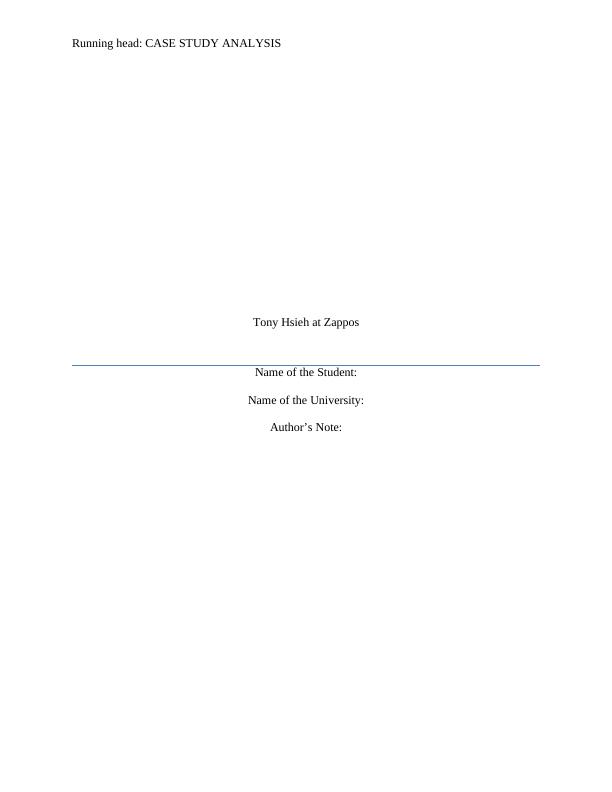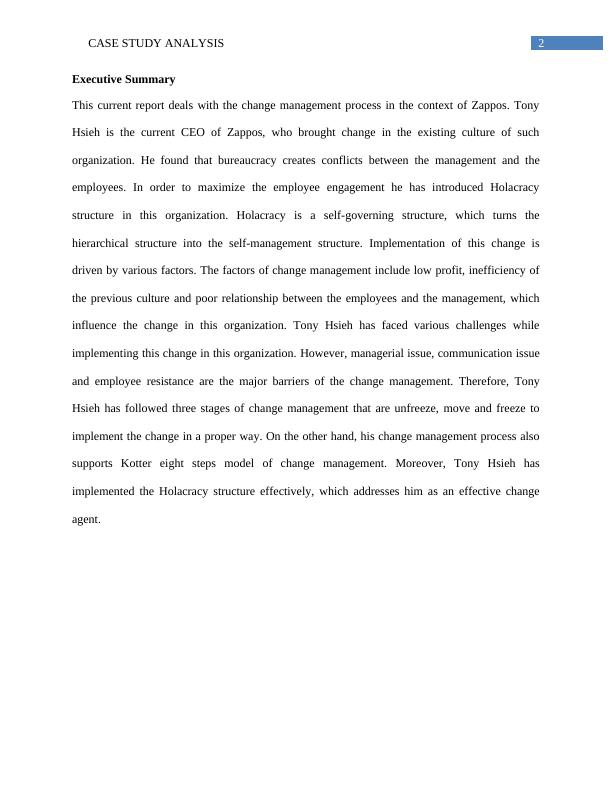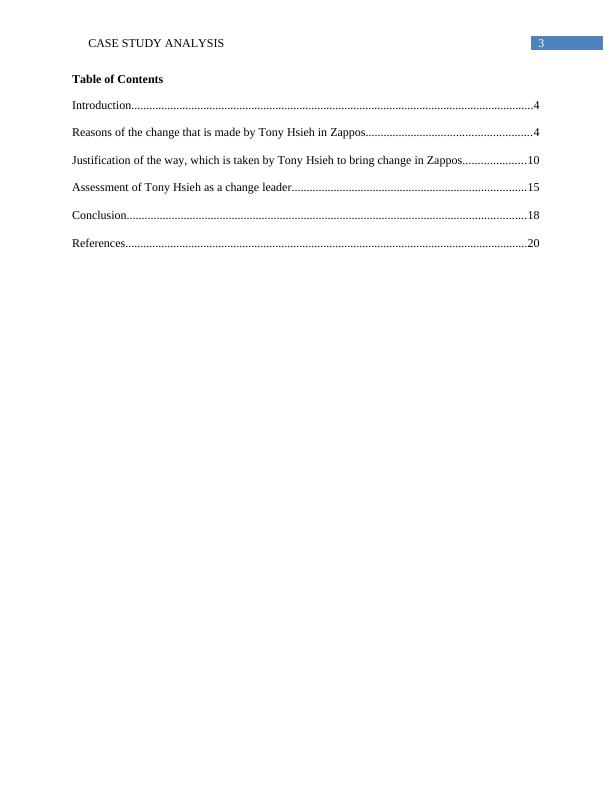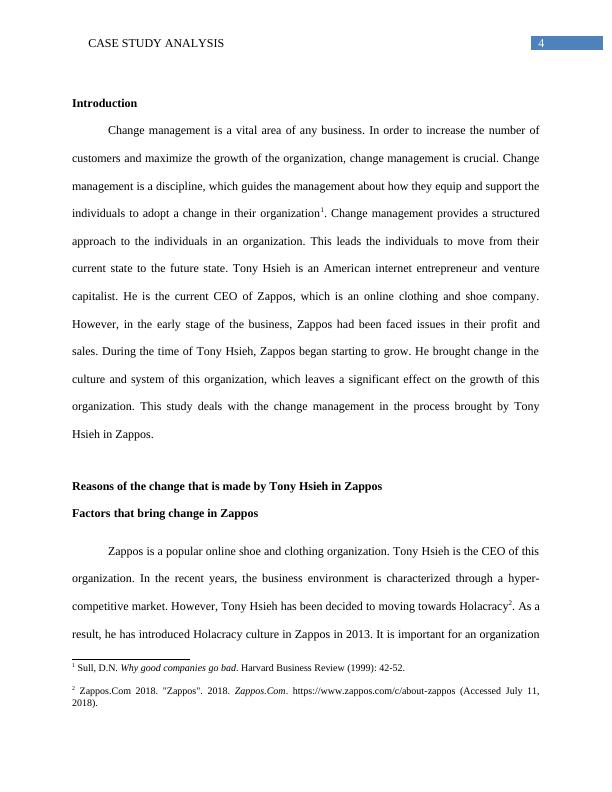Ask a question from expert
Case Study Analysis of Zappos
21 Pages4906 Words74 Views
Added on 2020-04-29
Case Study Analysis of Zappos
Added on 2020-04-29
BookmarkShareRelated Documents
Running head: CASE STUDY ANALYSIS
Tony Hsieh at Zappos
Name of the Student:
Name of the University:
Author’s Note:
Tony Hsieh at Zappos
Name of the Student:
Name of the University:
Author’s Note:

2CASE STUDY ANALYSIS
Executive Summary
This current report deals with the change management process in the context of Zappos. Tony
Hsieh is the current CEO of Zappos, who brought change in the existing culture of such
organization. He found that bureaucracy creates conflicts between the management and the
employees. In order to maximize the employee engagement he has introduced Holacracy
structure in this organization. Holacracy is a self-governing structure, which turns the
hierarchical structure into the self-management structure. Implementation of this change is
driven by various factors. The factors of change management include low profit, inefficiency of
the previous culture and poor relationship between the employees and the management, which
influence the change in this organization. Tony Hsieh has faced various challenges while
implementing this change in this organization. However, managerial issue, communication issue
and employee resistance are the major barriers of the change management. Therefore, Tony
Hsieh has followed three stages of change management that are unfreeze, move and freeze to
implement the change in a proper way. On the other hand, his change management process also
supports Kotter eight steps model of change management. Moreover, Tony Hsieh has
implemented the Holacracy structure effectively, which addresses him as an effective change
agent.
Executive Summary
This current report deals with the change management process in the context of Zappos. Tony
Hsieh is the current CEO of Zappos, who brought change in the existing culture of such
organization. He found that bureaucracy creates conflicts between the management and the
employees. In order to maximize the employee engagement he has introduced Holacracy
structure in this organization. Holacracy is a self-governing structure, which turns the
hierarchical structure into the self-management structure. Implementation of this change is
driven by various factors. The factors of change management include low profit, inefficiency of
the previous culture and poor relationship between the employees and the management, which
influence the change in this organization. Tony Hsieh has faced various challenges while
implementing this change in this organization. However, managerial issue, communication issue
and employee resistance are the major barriers of the change management. Therefore, Tony
Hsieh has followed three stages of change management that are unfreeze, move and freeze to
implement the change in a proper way. On the other hand, his change management process also
supports Kotter eight steps model of change management. Moreover, Tony Hsieh has
implemented the Holacracy structure effectively, which addresses him as an effective change
agent.

3CASE STUDY ANALYSIS
Table of Contents
Introduction......................................................................................................................................4
Reasons of the change that is made by Tony Hsieh in Zappos.......................................................4
Justification of the way, which is taken by Tony Hsieh to bring change in Zappos.....................10
Assessment of Tony Hsieh as a change leader..............................................................................15
Conclusion.....................................................................................................................................18
References......................................................................................................................................20
Table of Contents
Introduction......................................................................................................................................4
Reasons of the change that is made by Tony Hsieh in Zappos.......................................................4
Justification of the way, which is taken by Tony Hsieh to bring change in Zappos.....................10
Assessment of Tony Hsieh as a change leader..............................................................................15
Conclusion.....................................................................................................................................18
References......................................................................................................................................20

4CASE STUDY ANALYSIS
Introduction
Change management is a vital area of any business. In order to increase the number of
customers and maximize the growth of the organization, change management is crucial. Change
management is a discipline, which guides the management about how they equip and support the
individuals to adopt a change in their organization1. Change management provides a structured
approach to the individuals in an organization. This leads the individuals to move from their
current state to the future state. Tony Hsieh is an American internet entrepreneur and venture
capitalist. He is the current CEO of Zappos, which is an online clothing and shoe company.
However, in the early stage of the business, Zappos had been faced issues in their profit and
sales. During the time of Tony Hsieh, Zappos began starting to grow. He brought change in the
culture and system of this organization, which leaves a significant effect on the growth of this
organization. This study deals with the change management in the process brought by Tony
Hsieh in Zappos.
Reasons of the change that is made by Tony Hsieh in Zappos
Factors that bring change in Zappos
Zappos is a popular online shoe and clothing organization. Tony Hsieh is the CEO of this
organization. In the recent years, the business environment is characterized through a hyper-
competitive market. However, Tony Hsieh has been decided to moving towards Holacracy2. As a
result, he has introduced Holacracy culture in Zappos in 2013. It is important for an organization
1 Sull, D.N. Why good companies go bad. Harvard Business Review (1999): 42‐52.
2 Zappos.Com 2018. "Zappos". 2018. Zappos.Com. https://www.zappos.com/c/about-zappos (Accessed July 11,
2018).
Introduction
Change management is a vital area of any business. In order to increase the number of
customers and maximize the growth of the organization, change management is crucial. Change
management is a discipline, which guides the management about how they equip and support the
individuals to adopt a change in their organization1. Change management provides a structured
approach to the individuals in an organization. This leads the individuals to move from their
current state to the future state. Tony Hsieh is an American internet entrepreneur and venture
capitalist. He is the current CEO of Zappos, which is an online clothing and shoe company.
However, in the early stage of the business, Zappos had been faced issues in their profit and
sales. During the time of Tony Hsieh, Zappos began starting to grow. He brought change in the
culture and system of this organization, which leaves a significant effect on the growth of this
organization. This study deals with the change management in the process brought by Tony
Hsieh in Zappos.
Reasons of the change that is made by Tony Hsieh in Zappos
Factors that bring change in Zappos
Zappos is a popular online shoe and clothing organization. Tony Hsieh is the CEO of this
organization. In the recent years, the business environment is characterized through a hyper-
competitive market. However, Tony Hsieh has been decided to moving towards Holacracy2. As a
result, he has introduced Holacracy culture in Zappos in 2013. It is important for an organization
1 Sull, D.N. Why good companies go bad. Harvard Business Review (1999): 42‐52.
2 Zappos.Com 2018. "Zappos". 2018. Zappos.Com. https://www.zappos.com/c/about-zappos (Accessed July 11,
2018).

5CASE STUDY ANALYSIS
to bring changes in their existing structure to maximize the growth and to enhance the sale3.
Holacracy is a philosophy, which focuses on the self-supported structure. This philosophy leads
the organization towards the self-engagement. This change is brought by Tony Hsieh to improve
the structure and bring a new culture in the organization. Various reasons are associated with this
new change in Zappos. Both external and internal reasons are associated with the change
management. Dynamic failure is a big internal reason that leads the organization to bring
changes in their existing system. However, dynamic failure occurs due to the poor strategic
framework, process, relationship, and values.
One of the major reasons of this new change is the huge competition in the market. In the
recent years, the global market includes huge competition. In order to survive in the global
market, an organization needs to modify its existing system and organizational structure4. Online
marketing is a common and popular trend in the recent years. Many fashion organizations are
involved in improving the feature of their online marketing. This creates a huge competition in
the global market and it brings a threat for this organization. As a result, they have faced high
competition in the global market, which leads Tony Hsieh to introduce Holacracy culture in their
organization. The strategic framework of Zappos was strong, which facilitates this new culture
in this organization. This is the major strength of this organization. This culture encourages the
employees to do their work properly, which brings an opportunity for this organization to boost
their employee engagement. On the other hand, such Holacracy culture is a unique culture,
which makes Zappos unique in the competitive market and this organization is able to bring
success.
3 Sull, D.N. Why good companies go bad. Harvard Business Review (1999): 42‐52.
4 Hofer, Charles W. "Turnaround strategies." Journal of Business Strategy 1, no. 1 (1980): 19-31.
to bring changes in their existing structure to maximize the growth and to enhance the sale3.
Holacracy is a philosophy, which focuses on the self-supported structure. This philosophy leads
the organization towards the self-engagement. This change is brought by Tony Hsieh to improve
the structure and bring a new culture in the organization. Various reasons are associated with this
new change in Zappos. Both external and internal reasons are associated with the change
management. Dynamic failure is a big internal reason that leads the organization to bring
changes in their existing system. However, dynamic failure occurs due to the poor strategic
framework, process, relationship, and values.
One of the major reasons of this new change is the huge competition in the market. In the
recent years, the global market includes huge competition. In order to survive in the global
market, an organization needs to modify its existing system and organizational structure4. Online
marketing is a common and popular trend in the recent years. Many fashion organizations are
involved in improving the feature of their online marketing. This creates a huge competition in
the global market and it brings a threat for this organization. As a result, they have faced high
competition in the global market, which leads Tony Hsieh to introduce Holacracy culture in their
organization. The strategic framework of Zappos was strong, which facilitates this new culture
in this organization. This is the major strength of this organization. This culture encourages the
employees to do their work properly, which brings an opportunity for this organization to boost
their employee engagement. On the other hand, such Holacracy culture is a unique culture,
which makes Zappos unique in the competitive market and this organization is able to bring
success.
3 Sull, D.N. Why good companies go bad. Harvard Business Review (1999): 42‐52.
4 Hofer, Charles W. "Turnaround strategies." Journal of Business Strategy 1, no. 1 (1980): 19-31.

6CASE STUDY ANALYSIS
Poor shopping experience is another reason that leads Zappos to as well as Tony Hsieh to
introduce Hocracy culture in their organization. The operating process was not effective in
Zappos, which hampers their growth. In the year 1990, Zappos had faced a frustrating shopping
experience in their organization. This left a negative impact on this organization. This is due to
the less employee engagement in this organization. Tony Hsieh has identified in order to
improve the organizational culture and to maximize the growth employee engagement is crucial.
Based on the previous experience Tony Hsieh has decided to change their organizational
culture5. Another reason of establishing Holacracy structure is to encourage the employees. Tony
Hsieh wanted that employee should act more like an entrepreneur instead of doing what their
managers say. However, Tony Hsieh wants to ensure that productivity and innovation still take
place as the company grows. This is the major key driver of implementing this model in this
organization. For an organization, it is important to encourage their employees while bringing a
change in an organization6. This factor leads Tony Hsieh to implement Hocracy structure in
Zappos.
In Zappos as the sales continued to grow the company has established its warehouse in
Kentucky to manage their own inventory. Zappos is considered as the Amazon of shoes.
However, the customers are more delighted and they received their order within a couple of
days. Despite this effectiveness, the profit of this business is very low, which is a growing pain
of this business. This organization failed to give value to their stakeholders and to maintain a
proper strategic framework. In order to deal with this situation more employee engagement is
5 Thecasecentre.Org 2018. "Printer-Friendly Version Category Winner: Tony Hsieh At Zappos: Structure, Culture
And Radical Change". 2018. Thecasecentre.Org.
https://www.thecasecentre.org/educators/ordering/selecting/featuredcases/CompetitionWinners/zappos (Accessed
July 11, 2018).
6 Schmitt, Achim, Vincent L. Barker III, Sebastian Raisch, and David Whetten. "Strategic renewal in times of
environmental scarcity." Long Range Planning 49, no. 3 (2016): 361-376.
Poor shopping experience is another reason that leads Zappos to as well as Tony Hsieh to
introduce Hocracy culture in their organization. The operating process was not effective in
Zappos, which hampers their growth. In the year 1990, Zappos had faced a frustrating shopping
experience in their organization. This left a negative impact on this organization. This is due to
the less employee engagement in this organization. Tony Hsieh has identified in order to
improve the organizational culture and to maximize the growth employee engagement is crucial.
Based on the previous experience Tony Hsieh has decided to change their organizational
culture5. Another reason of establishing Holacracy structure is to encourage the employees. Tony
Hsieh wanted that employee should act more like an entrepreneur instead of doing what their
managers say. However, Tony Hsieh wants to ensure that productivity and innovation still take
place as the company grows. This is the major key driver of implementing this model in this
organization. For an organization, it is important to encourage their employees while bringing a
change in an organization6. This factor leads Tony Hsieh to implement Hocracy structure in
Zappos.
In Zappos as the sales continued to grow the company has established its warehouse in
Kentucky to manage their own inventory. Zappos is considered as the Amazon of shoes.
However, the customers are more delighted and they received their order within a couple of
days. Despite this effectiveness, the profit of this business is very low, which is a growing pain
of this business. This organization failed to give value to their stakeholders and to maintain a
proper strategic framework. In order to deal with this situation more employee engagement is
5 Thecasecentre.Org 2018. "Printer-Friendly Version Category Winner: Tony Hsieh At Zappos: Structure, Culture
And Radical Change". 2018. Thecasecentre.Org.
https://www.thecasecentre.org/educators/ordering/selecting/featuredcases/CompetitionWinners/zappos (Accessed
July 11, 2018).
6 Schmitt, Achim, Vincent L. Barker III, Sebastian Raisch, and David Whetten. "Strategic renewal in times of
environmental scarcity." Long Range Planning 49, no. 3 (2016): 361-376.

End of preview
Want to access all the pages? Upload your documents or become a member.
Related Documents
Management Issue in Zapposlg...
|13
|3191
|63
Holacracy and Zappos: The strategic changelg...
|12
|1434
|322
Leadership and Change Management INTROUCTIONlg...
|13
|4873
|320
Strategic Change Management Assignmentlg...
|6
|1127
|139
Business Strategy and Organizational Culturelg...
|11
|896
|133
Zappos Case Analysis - Ethical Climate, Core Values, Challenges and Solutionslg...
|9
|2149
|368